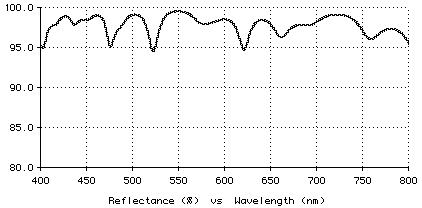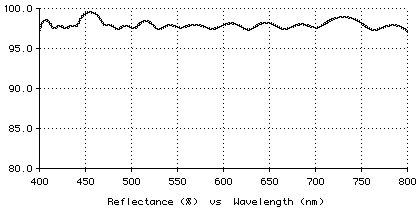Broadband High-Reflection Coating at 50 Degrees
-
Konstantin V. Popov, J.A. Dobrowolski, Alexander V. Tikhonravov, and Brian T. Sullivan,
"Broadband high-reflection multilayer coatings at oblique angles of incidence," Applied Optics,
Vol. 36, No. 10, 1 April 1997, pp. 2139-2151.
The goal is to design a high reflector which operates in the wavelength range 400-800 nm at a 50 degree angle of incidence. Because this coating is at 50 degrees, the reflectance of S polarization will be much higher than P. Hence, we can concentrate on controlling the reflectance for P polarization. The coating, composed of layers of L (index 1.45) and H (index 2.35), is to be deposited on glass G (index 1.52). The incident medium is air (index 1.0).
The formulas in the paper lead to a 3-stack (7 periods/stack) design whose stacks are centered at wavelengths 705, 555, and 437 nm. To increase the reflectance, the authors add one additional H layer next to the substrate. The result is a 43-layer coating whose average P reflectance is 98%.
TFCalc can be used to design and refine this type of coating. The starting design is a 43-layer coating with the stack formula
-
G a(HL)^7 b(H(LH)^7) c(LH)^7 air
-
a = 1.2000, b = 1.0000, c = 0.8000,
-
a = 1.3260, b = 1.0171, c = 0.7855.


H 97.87
L 171.35
H 80.56
L 152.15
H 74.35
L 154.04
H 83.10
L 178.45
H 72.02
L 129.75
H 85.36
L 141.64
H 82.96
L 141.89
H 71.17
L 137.71
H 69.96
L 104.04
H 55.42
L 113.89
H 71.53
L 121.61
H 63.21
L 111.11
H 61.47
L 121.69
H 63.51
L 101.69
H 56.86
L 101.16
H 52.26
L 82.60
H 46.62
L 94.22
H 53.49
L 90.92
H 46.16
L 86.62
H 51.59
L 91.80
H 45.96
L 80.64
H 49.35